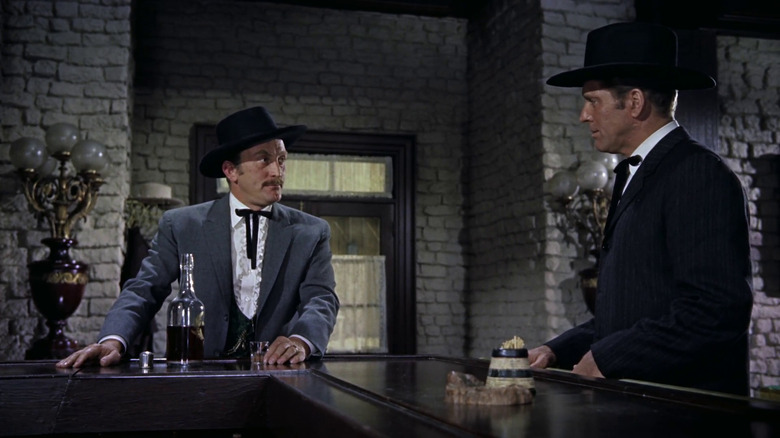Kirk Douglas Had To Carefully Choreograph Every Cough In Gunfight At The O.K. Corral
It was the shootout that elevated the likes of Wyatt Earp and dentist-turned-gunslinger Doc Holiday to mythic status. Several features have honored the fabled event, but John Sturges' "Gunfight at the O.K. Corral" stands tall as one of the most illustrious retellings of the infamous 1881 Tombstone, Arizona shootout.
The classic western stars Burt Lancaster as Wyatt Earp and a bristled Kirk Douglas as Holiday, in one of their several big-screen collaborations. Stricken with tuberculosis, Holiday's scenes are earmarked by an intermittent tickle in the throat that, over the runtime, progresses to a full-blown hack. "This kind of cough doesn't go away," he tells the lawman, but he won't resign himself to a slow, peaceful death. Never cowering, whether by the bullet or by bacteria, Douglas keeps his character's physical ailments wrapped under a thick cloak of steely-eyed grit. Earp saves his life from a lynch mob, earning loyalty – and in his own estimation, a life debt – from the hawkeyed killer. "If I'm going to die," he growls to Jo Van Fleet's Kate Fisher, "at least let me die with the only friend I ever had."
Holiday spends much of his time in some kind of peril, whether by a drunk gunman with a grudge or a bloodthirsty posse, but the silent killer is that cough of his. It'll show up as a chuckle gets away from him, or in the aftermath of a nighttime skirmish, but it never overwhelms Douglas' performance as the kind of unyielding antihero that would echo in his career-defining turn in "Spartacus" three years later. According to the "Paths of Glory" star, each cough was charted such that it never took up more screen presence than the man carrying it.
Every cough is sacred
Leon Uris' screenplay for "O.K. Corral," based on George Scullinwas' 1954 article "The Killer" in Holiday Magazine, was a far cry from the real historical events. A handful of features have chronicled the showdown between the Earp brothers, Holiday, and the cattle-rustling Clanton gang, each one the definitive version of the story until the next one emerged. There's Allan Dwan's 1939 monochrome effort "Frontier Marshall," followed up by John Ford's "My Darling Clementine" in 1946. Following "Gunfight" in 1957, further accounts include "Hour of the Gun," "Wyatt Earp," and the widely lauded "Tombstone," the latter starring a wan but lively-in-spirit Val Kilmer as the deadly Doc.
In his memoir, Kilmer looks back on his iteration of Holiday as "defiance in the face of death," an attitude that crops up through his color-drained face, similar to Douglas' resolute stoicism through sheens of sweat. The latter's autobiography "A Ragman's Son" explains that Douglas took pains to ensure that his character's hacking didn't dominate his own brand of stoicism:
"I had to cough a lot in 'Gunfight at the O.K. Corral,' and I had to choreograph every cough. Since movies are not shot in sequence, I had to plan where I was going to cough, how lightly or deeply, and where I was going to have an attack. In some scenes, I didn't cough at all. Nothing would be more annoying than to be coughing in every scene. A movie is not real. You create the illusion you want to create."
The result was one of distance and unflagging valiance, like the William Holdens and Montgomery Clifts of the era, occupied not so much with winning an audience over as delivering "the illusion" and, like Holiday paying off his life debt to Earp, getting the job done.

